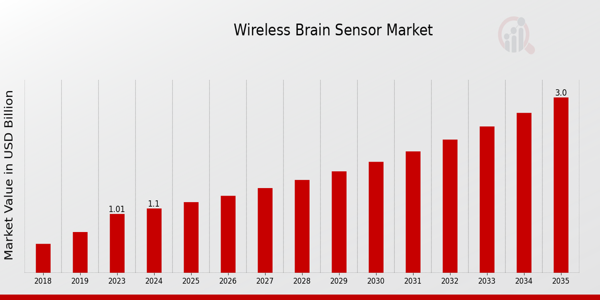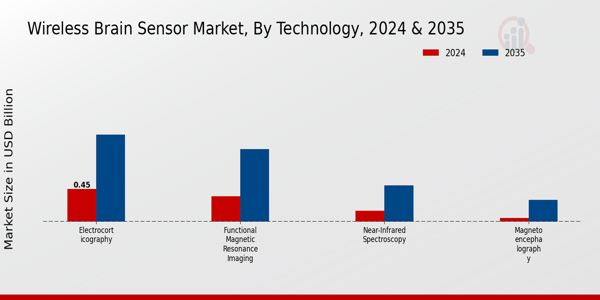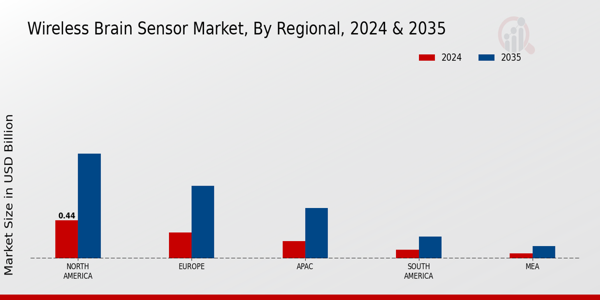Wireless Brain Sensor Market Overview
As per MRFR analysis, the Wireless Brain Sensor Market Size was estimated at 1.01 (USD Billion) in 2023. The Wireless Brain Sensor Market Industry is expected to grow from 1.1(USD Billion) in 2024 to 3.0 (USD Billion) by 2035. The Wireless Brain Sensor Market CAGR (growth rate) is expected to be around 9.52% during the forecast period (2025 - 2035).
Key Wireless Brain Sensor Market Trends Highlighted
The Global Wireless Brain Sensor Market is significantly driven by the increasing demand for advanced medical diagnostics and monitoring tools. As neurological disorders such as epilepsy, stroke, and trauma continue to rise, healthcare providers are seeking efficient and patient-friendly solutions. Wireless technology allows for real-time patient monitoring, reduces the burden of hospital visits, and enhances overall healthcare delivery. This trend is complemented by technological advancements, such as miniaturization of devices and improved signal processing capabilities, leading to more effective and less invasive treatment options. There are numerous opportunities to be explored in this market, particularly in developing countries where access to quality healthcare is limited.Investments in healthcare infrastructure can open up avenues for adopting wireless brain sensors. Furthermore, collaborations between tech companies and healthcare providers can foster innovation in sensor technology, leading to customized solutions for various neurological conditions. The ongoing research to improve sensor efficacy offers a pathway to more comprehensive healthcare solutions. Moreover, as home healthcare gains popularity, the potential for wireless brain sensors to provide at-home monitoring becomes increasingly appealing, thereby enhancing patient comfort and convenience. Recent trends indicate a growing interest in creating user-friendly interfaces and applications that enable patients to easily interact with their brain sensors.This shift towards consumer-centric design is essential for increasing user compliance and improving health outcomes. Additionally, there is an increasing focus on data security and privacy, with innovations aimed at protecting sensitive patient information. The convergence of artificial intelligence with wireless brain sensors is also gaining traction, paving the way for predictive analytics in neurological health. Overall, the market is poised for significant growth, driven by technological advancements and an increasing need for effective healthcare solutions.

Source: Primary Research, Secondary Research, MRFR Database and Analyst Review
Wireless Brain Sensor Market Drivers
Technological Advancements in Wireless Sensor Technology
The Global Wireless Brain Sensor Market Industry is experiencing significant growth driven by continuous technological advancements in wireless sensor technology. The evolution of micro-electromechanical systems (MEMS) has led to the development of smaller, more efficient, and highly sensitive sensors that can accurately monitor brain activity. These innovations enable the collection of real-time and precise data, making it easier for healthcare professionals to diagnose and treat various neurological conditions.Furthermore, advancements in data transmission and connectivity have enhanced the capabilities of these sensors, allowing for seamless integration with mobile devices and cloud-based platforms. As wireless brain sensors become more sophisticated, their applications in both clinical and research settings expand. Consequently, increased demand for non-invasive monitoring methods and improved patient outcomes will further spur the growth of the Global Wireless Brain Sensor Market Industry.Healthcare providers are increasingly adopting wireless brain sensors due to their ability to facilitate remote monitoring, reduce the need for hospitalization, and empower patients their health. Moreover, the rising incidence of neurological disorders and growing awareness about mental health issues are also contributing to the expansion of this market. In addition, collaborations between technology firms and healthcare organizations are fostering innovation and helping to bring more advanced wireless brain sensors to the market.
Growing Prevalence of Neurological Disorders
The increasing prevalence of neurological disorders is a crucial driver for the Global Wireless Brain Sensor Market Industry. Conditions such as Alzheimer’s, epilepsy, and Parkinson’s disease are on the rise due to an aging population and lifestyle factors. This surge in cases necessitates effective diagnostic and monitoring solutions, propelling the demand for wireless brain sensors. Non-invasive and user-friendly sensors play a pivotal role in providing timely insights into brain activity, which is vital for enhancing patient care.
Increased Focus on Remote Patient Monitoring
There is a growing emphasis on remote patient monitoring in the healthcare sector, significantly influencing the Global Wireless Brain Sensor Market Industry. Wireless brain sensors facilitate real-time tracking of neurological conditions outside traditional clinical settings, which is increasingly important for managing chronic illnesses. The COVID-19 pandemic accelerated the shift towards telehealth solutions, making it essential for patients to have access to effective remote monitoring tools.This trend enhances patient engagement while reducing hospitalization costs, further driving market growth.
Wireless Brain Sensor Market Segment Insights
Wireless Brain Sensor Market Technology Insights
The Global Wireless Brain Sensor Market is experiencing considerable growth, particularly within the Technology segment, which encompasses distinct modalities such as Electrocorticography, Functional Magnetic Resonance Imaging, Near-Infrared Spectroscopy and Magnetoencephalography. The overall market is projected to achieve a valuation of 1.1 billion USD by 2024, signifying a robust interest in innovative technologies for monitoring and analyzing brain activity. Within this landscape, Electrocorticography stands out with a projected value of 0.45 billion USD in 2024 and is expected to grow to 1.2 billion USD by 2035, marking its position as the leading technology due to its high accuracy and real-time monitoring capabilities.Functional Magnetic Resonance Imaging, with a value of 0.35 billion USD in 2024 projected to rise to 1.0 billion USD by 2035, holds significant relevance in assessing brain functions and investigating neurological disorders.
Near-Infrared Spectroscopy, while smaller in scale with an initial value of 0.15 billion USD in 2024, is anticipated to grow to 0.5 billion USD by 2035, indicating an emerging interest in non-invasive monitoring techniques. Meanwhile, Magnetoencephalography has a modest valuation of 0.05 billion USD in 2024, expected to increase to 0.3 billion USD by 2035, highlighting its niche but essential role in studying brain activity patterns.The market growth is driven by technological advancements and increased demand for non-invasive monitoring approaches, supported by rising prevalence of neurological disorders. However, challenges such as high costs and limited accessibility may pose obstacles. Opportunities abound in expanding research initiatives and developing cost-effective solutions for broader clinical applications. Overall, the Global Wireless Brain Sensor Market data reflects promising growth trends and significant potential across these technological areas as they cater to the evolving needs of the healthcare industry.

Source: Primary Research, Secondary Research, MRFR Database and Analyst Review
Wireless Brain Sensor Market Application Insights
The Global Wireless Brain Sensor Market is poised for substantial growth, Key areas include Neurosurgery, where the use of wireless brain sensors enhances surgical procedures and patient monitoring, improving outcomes. Neuromodulation is gaining traction due to its relevance in treating neurological disorders, contributing significantly to market dynamics. Mental Health Monitoring is also becoming increasingly important, as real-time tracking of brain activity helps in early detection and personalized treatment of mental health issues.Cognitive Research plays a vital role in advancing our understanding of brain functions encouraging innovation in wireless sensor technology. The combination of these applications drives demand and presents numerous opportunities, with the market expected to evolve substantially by 2035. Additionally, challenges such as technological standardization and data privacy need to be addressed to ensure sustained market growth. Overall, the Global Wireless Brain Sensor Market segmentation reveals diverse applications that collectively contribute to the industry’s upward trajectory.
Wireless Brain Sensor Market End Use Insights
The Global Wireless Brain Sensor Market is expected to demonstrate significant growthWithin the overall market, the end-use segment plays a crucial role in driving this growth. Hospitals are vital as they demand advanced monitoring technologies capable of tracking brain activity in time, improving patient outcomes and reducing costs. Research institutions leverage wireless brain sensors for innovative studies in neuroscience, paving the way for breakthroughs in treatment methods.Clinics focus on outpatient services find these technologies instrumental in providing patient-centric care that enhances diagnostic accuracy. Home care is an emerging area where wireless brain sensors enable patients to manage their conditions independently while maintaining a link to healthcare providers, thus fostering a proactive approach to health management. The diverse applications across these areas underscore their importance in shaping the future of brain health monitoring. Overall, the insights derived from Global Wireless Brain Sensor Market data indicate a dynamic landscape driven by increasing demand for technology that can enhance healthcare delivery and patient management across multiple settings.
Wireless Brain Sensor Market Patient Type Insights
The Global Wireless Brain Sensor Market is poised for substantial growth, reflecting the increasing demand for advanced monitoring solutions across varied patient demographics. Within the Patient Type category, Adults represent a significant share due to the rising prevalence of neurological disorders and the increasing adoption of technology for remote monitoring. The Pediatric segment, while smaller, is essential as it addresses the unique needs of children requiring innovative approaches in brain health monitoring due to developmental considerations.The Geriatric population is also noteworthy, as this group often experiences age-related cognitive decline, necessitating advanced brain sensing technologies for effective management and real-time health tracking. Overall, the segmentation of the Global Wireless Brain Sensor Market reveals diverse needs, with each group contributing to its growth trajectory, thereby presenting opportunities for targeted advancements and improvements in patient care. Understanding these distinct segments enhances awareness of how technology can address the specific challenges faced by different age groups, fostering a more personalized approach to neurological health.
Wireless Brain Sensor Market Regional Insights
The Global Wireless Brain Sensor Market is showing promising growth across different regions, with North America leading the way, valued at 0.44 USD Billion in 2024 and increasing to 1.2 USD Billion by 2035, showcasing its majority holding in the market. Europe follows, with a value of 0.3 USD Billion in 2024, rising to 0.83 USD Billion in 2035, signifying its significant presence and technological advancements in brain sensor applications. The Asia-Pacific (APAC) region, valued at 0.2 USD Billion in 2024 and expected to reach 0.58 USD Billion in 2035, is witnessing rapid adoption due to increasing healthcare needs and advancements in technology.South America, while smaller, is growing with a valuation of 0.1 USD Billion in 2024 and projected to reach 0.25 USD Billion by 2035, reflecting the potential for market growth in emerging economies. The Middle East and Africa (MEA) segment, valued at 0.06 USD Billion in 2024 and increasing to 0.14 USD Billion in 2035, remains the least dominant but is notable for its opportunity for expanding healthcare technologies. Overall, the Global Wireless Brain Sensor Market is driven by advancements in medical technology, rising awareness of brain health, and the need for innovative healthcare solutions.

Source: Primary Research, Secondary Research, MRFR Database and Analyst Review
Wireless Brain Sensor Market Key Players and Competitive Insights
The Global Wireless Brain Sensor Market has been rapidly evolving due to advancements in technology and an increasing demand for non-invasive medical devices. This market comprises various players that focus on delivering innovative solutions for monitoring neurological conditions and enhancing patient well-being. Competitive insights within this realm showcase a robust landscape where emerging start-ups are challenging well-established brands, promoting an environment ripe for collaboration, mergers, and acquisitions. The continuous push for improvement in sensor accuracy, battery life, and user-friendly designs also intensifies the competition, urging companies to enhance their research and development capabilities. As brain health gains prominence globally, the market is expected to experience significant growth, with companies vying to capture market share through strategic positioning and differentiation.Abbott Laboratories holds a significant position within the Global Wireless Brain Sensor Market due to its commitment to innovation and the development of state-of-the-art neurological monitoring devices.
The company leverages its extensive experience in the healthcare sector to introduce advanced wireless brain sensors that offer real-time data to healthcare professionals and patients. With a strong emphasis on research and development, Abbott Laboratories has established itself as a leader by integrating cutting-edge technology that enhances the overall effectiveness of brain monitoring solutions. The company’s reputation for high-quality products and a rigorous focus on regulatory compliance further strengthens its market presence, enabling it to build lasting relationships with healthcare providers and stakeholders.NICO Corporation is also a prominent player in the Global Wireless Brain Sensor Market, focusing on harnessing advanced technology to improve brain health monitoring. The company specializes in developing minimally invasive tools that allow for accurate data collection and analysis of brain activity. This focus on innovation sets NICO Corporation apart as it addresses some of the critical needs within the market, particularly in terms of improving patient outcomes. With a growing portfolio of wireless brain sensor products that aim to facilitate both clinical and personal use, NICO Corporation is positioned to make significant strides in the sector. The collaborative approach and strategic partnerships with other technology and healthcare organizations further enhance its capabilities, ensuring competitiveness in a rapidly changing market landscape.
Key Companies in the Wireless Brain Sensor Market Include
- Abbott Laboratories
- NICO Corporation
- CureMetrix
- Advanced Brain Monitoring
- Cerebrotech Medical Systems
- Neuralink
- Blackrock Neurotech
- G. T. E. S.
- Neurescue
- NeuroSky
- Elekta
- Boston Scientific
- BrainCo
- Medtronic
- Cadwell Industries
Wireless Brain Sensor Market Industry Developments
Recent developments in the Global Wireless Brain Sensor Market have been marked by significant innovations and advancements from key players. Companies like Neuralink and Blackrock Neurotech are pushing boundaries in neurotechnology, focusing on enhancing brain-computer interfaces. Abbott Laboratories is reportedly diversifying its product line to include more advanced sensors, responding to increasing demand in patient monitoring and neurological research. CureMetrix has made strides in improving software algorithms for interpreting brain data, which enhances the effectiveness of their wireless brain sensors.
Advanced Brain Monitoring is also gaining traction with their non-invasive solutions designed for sleep and cognitive function monitoring. Notably, merger and acquisition activities are stirring the market, with Medtronic expanding its footprint through recent acquisitions aimed at boosting their neurostimulation technologies. Furthermore, Boston Scientific is exploring partnerships to integrate innovative wireless solutions into its portfolio, which is indicative of a growing trend toward collaboration in the sector. The market's valuation is projected to rise significantly as these advancements revolutionize treatment methods and improve patient outcomes, attracting more investments and paving the way for further enhancements in technology and applications.
Wireless Brain Sensor Market Segmentation Insights
Wireless Brain Sensor Market Technology Outlook
- Electrocorticography
- Functional Magnetic Resonance Imaging
- Near-Infrared Spectroscopy
- Magnetoencephalography
Wireless Brain Sensor Market Application Outlook
- Neurosurgery
- Neuromodulation
- Mental Health Monitoring
- Cognitive Research
Wireless Brain Sensor Market End Use Outlook
- Hospitals
- Research Institutions
- Clinics
- Home Care
Wireless Brain Sensor Market Patient Type Outlook
- Adults
- Pediatric
- Geriatric
Wireless Brain Sensor Market Regional Outlook
- North America
- Europe
- South America
- Asia Pacific
- Middle East and Africa
| Attribute/Metric Source: |
Details |
| MARKET SIZE 2023 |
1.01(USD Billion) |
| MARKET SIZE 2024 |
1.1(USD Billion) |
| MARKET SIZE 2035 |
3.0(USD Billion) |
| COMPOUND ANNUAL GROWTH RATE (CAGR) |
9.52% (2025 - 2035) |
| REPORT COVERAGE |
Revenue Forecast, Competitive Landscape, Growth Factors, and Trends |
| BASE YEAR |
2024 |
| MARKET FORECAST PERIOD |
2025 - 2035 |
| HISTORICAL DATA |
2019 - 2024 |
| MARKET FORECAST UNITS |
USD Billion |
| KEY COMPANIES PROFILED |
Abbott Laboratories, NICO Corporation, CureMetrix, Advanced Brain Monitoring, Cerebrotech Medical Systems, Neuralink, Blackrock Neurotech, G. T. E. S., Neurescue, NeuroSky, Elekta, Boston Scientific, BrainCo, Medtronic, Cadwell Industries |
| SEGMENTS COVERED |
Technology, Application, End Use, Patient Type, Regional |
| KEY MARKET OPPORTUNITIES |
Increased demand for remote monitoring, Advancements in neurological treatments, Growing prevalence of neurological disorders, Rising adoption in sports medicine, Expanded use in research settings |
| KEY MARKET DYNAMICS |
Growing demand for remote monitoring, Advancements in neurotechnology, Increasing prevalence of neurological disorders, Rising adoption of wearable devices, Strong investment in research and development |
| COUNTRIES COVERED |
North America, Europe, APAC, South America, MEA |
Frequently Asked Questions (FAQ) :
The Global Wireless Brain Sensor Market is expected to be valued at 1.1 USD Billion in 2024.
By 2035, the Global Wireless Brain Sensor Market is anticipated to reach a valuation of 3.0 USD Billion.
The expected compound annual growth rate (CAGR) for the Global Wireless Brain Sensor Market from 2025 to 2035 is 9.52%.
In 2024, North America is projected to hold the largest market share, valued at 0.44 USD Billion.
The Electrocorticography segment of the Global Wireless Brain Sensor Market is expected to be valued at 1.2 USD Billion by 2035.
Key players in the Global Wireless Brain Sensor Market include Abbott Laboratories, NICO Corporation, and Medtronic among others.
The market size for the Functional Magnetic Resonance Imaging technology is expected to be 0.35 USD Billion in 2024.
The APAC region shows significant growth potential, increasing from 0.2 USD Billion in 2024 to 0.58 USD Billion by 2035.
By 2035, the market size for Near-Infrared Spectroscopy technology is expected to reach 0.5 USD Billion.
The Magnetoencephalography segment is projected to grow the least, reaching 0.3 USD Billion by 2035.

















